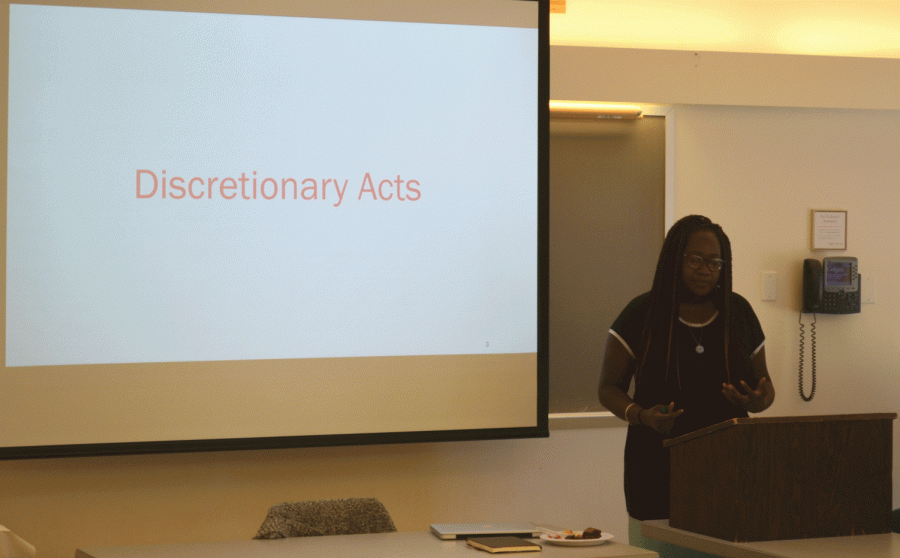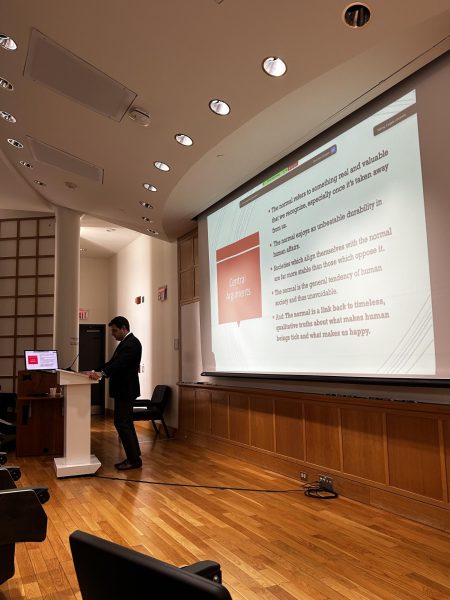Sanya Discusses Difficulties of African Immigrants
Professor Brenda N. Sanya shares her thoughts on educational and social infrastructure complications for African immigrants in the United States.
On Thursday, September 21, Visiting Assistant Professor of Educational Studies Brenda N. Sanya discussed the subject of African immigrants and the complexities of the educational and social infrastructures that define their treatment in American society and the media. Sanya’s Brown Bag, located in Persson Hall and titled, “Discretionary Acts: African Immigrants Negotiating American Exceptionalism and the Limits of Educational Attainment” delved into the topic of legal immigration and the realities of the treatment of African immigrants in America.
Sanya conducted research on what she calls “States of Discretion” – on black migrating bodies and the level of “citizenship” that results from legal black migration to the United States. She noted how despite the high level of education most African immigrants have due to the selective process of legal immigration, these new members of American society do not experience the full benefits of what legal American, state-issued immigration documentation should entail.
While education in itself can be regarded as a form of “citizenship-making,” Sanya argues that these highly educated individuals that immigrate to the U.S. continually have their rights suppressed by state authorities due to race. Sanya cites media responses and news articles to underscore the cultural implications of these state-perpetrated crimes.
A key figure in Sanya’s discussion was Amadou Diallo, a francophone immigrant from Guinea, who in 1999 was shot by a New York Police Department officer while unarmed. Diallo had received higher education from a university affiliated with Cambridge. However, the visibility and value of this education was limited due to the fact that he was not educated by an English-speaking school. As Sanya describes it, the social privilege that generally comes with education quite literally does not translate.
Following his murder, news reports rarely brought up the topic of race, but rather focused on Diallo’s immigration status. Diallo’s “Africanness” and immigrant status allowed him to be implicitly understood as “innocent,” in contrast to the way that African-Americans are often assumed to be guilty of criminality. Most of the articles included anecdotes from family and friends, painting Diallo as a figure of innocence. The social issue mentioned was police excess – due to the 41 bullets that were shot at him – rather than racial-based prejudice on the part of the state.
Another example Sanya presented was the case of Ousmane Zongo, another unarmed black immigrant who was killed by a New York Police Department officer. In the press following his death, many comparisons were drawn between Zongo and Diallo due to the fact that both of them were African immigrants. However, of the multiple news articles studied by Sanya, very rarely was a connection made between the case of Zongo and other black people that were victims of crimes by the state.
The entirety of Sanya’s research begs the question of the value of and the true protection of legal immigration and state-issued documentation. In a country with a tumultuous landscape of racial prejudices like the United States, legal immigration is only valuable to a certain extent.
Despite levels of higher-education, race is visible to state infrastructures like the public school system or the law. Sanya even mentioned studies that found fourth generation descendents of African immigrants to perform the same in their educational careers as most all black students that were not descended from the same educational background as those of the African immigrants. Sanya suggests that something is being done to black students in schools.
Overall though, these narratives, that have become embedded in our culture concerning the topics of race and immigration, follow actions rather than preceding them. The way that the stories of Amadou Diallo and Ousmane Zongo are presented to the public through news media are based on narratives that have been created after the fact. The narratives of innocence surrounding the cases of Diallo and Zongo were created after the fact following knowledge of their families, occupations, immigration status, education and ultimately the fact that they were unarmed.
However, the much darker narrative – the one that calls to light true racial profiling and the realities of African immigration to the United States was nowhere to be found in the news. Sanya described African immigration to the United States as an experience characterized by elaborate inequality, false promises and ubiquitous surveillance.
According to data from the U.S. Census Bureau, African immigrants are currently one of the most educated groups in the United States. However, a key question of Sanya’s is how we can regard this highly educated population as thriving in a country where their rights are consistently suppressed by state authorities.
Contact Shelby Stevens at sstevens@colgate.edu.





